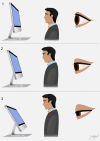Video display terminal use and dry eye: preventive measures and future perspectives
- PMID: 35122403
- PMCID: PMC9790652
- DOI: 10.1111/aos.15105
Video display terminal use and dry eye: preventive measures and future perspectives
Abstract
Background: Dry eye disease (DED) is a common cause of ocular pain and discomfort. Dry eye disease (DED) stems from a loss-of-tear film homeostasis and is frequently seen in video display terminal (VDT) users. Video display terminal (VDT) use reduces blink rates and increases incomplete blinks, leading to tear film instability and ocular inflammation, promoting DED.
Purpose: To assess and evaluate the methods for preventing VDT-associated DED and ocular discomfort.
Methods: Studies were found using PubMed and Embase with the search terms: (digital visual terminal* OR computer use OR screen use OR smartphone OR display OR visual display terminal* OR computer vision syndrome OR tablet OR phone OR screen time) AND (dry eye OR DED).
Results: Thirty-one relevant articles were found. Ten described single-visit studies, whereas 21 had a prolonged follow-up. Most preventive measures of VDT-associated DED aimed to increase blink rate or directly prevent tear film instability, ocular inflammation, mucin loss or ocular surface damage. Using an adjustable chair and ergonomic training, blink animations and omega-3 supplementation improved signs and symptoms of VDT-associated DED. Taking frequent breaks was associated with fewer symptoms, but no study assessed the commonly suggested 20-20-20 rule.
Conclusion: Preventive measures, such as blink animation programmes, oral intake of omega-3 fatty acids and improved ergonomics act on different parts of the vicious cycle of dry eye and could supplement each other. A comparison of the efficacy of the different interventions as well as more evidence of the effect of increased humidity, VDT filters and ergonomic practices, are required.
Keywords: computer vision syndrome; dry eye disease; ergonomic practices; preventive measures; tear film stability; video display terminal.
© 2022 The Authors. Acta Ophthalmologica published by John Wiley & Sons Ltd on behalf of Acta Ophthalmologica Scandinavica Foundation.
Figures






References
-
- Ang CK, Mohidin N & Chung KM (2014): Effects of wink glass on blink rate, nibut and ocular surface symptoms during visual display unit use. Curr Eye Res 39: 879–884. - PubMed
-
- Atreya K, Sitaula BK, Overgaard H, Bajracharya RM & Sharma S (2012): Knowledge, attitude and practices of pesticide use and acetylcholinesterase depression among farm workers in Nepal. Int J Environ Health Res 22: 401–415. - PubMed
Publication types
MeSH terms
Substances
LinkOut - more resources
Full Text Sources

